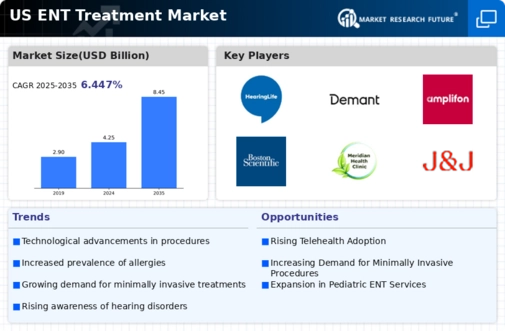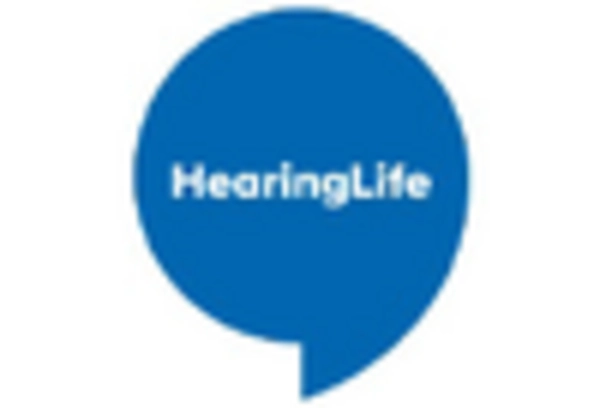Expansion of Telehealth Services
The rise of telehealth services is reshaping the landscape of the ent treatment market, particularly in the wake of increasing demand for accessible healthcare. Telemedicine allows patients to consult with ENT specialists remotely, reducing barriers to care such as travel and wait times. This trend is particularly beneficial for individuals in rural areas, where access to specialized care may be limited. According to recent surveys, nearly 70% of patients express a willingness to use telehealth for ENT consultations, indicating a strong market potential. As telehealth continues to gain traction, it is likely to drive growth in the ent treatment market, with projections suggesting an increase in telehealth-related services by around 5% annually. This shift not only enhances patient convenience but also expands the reach of healthcare providers.
Rising Incidence of ENT Disorders
The increasing prevalence of ear, nose, and throat disorders in the US is a primary driver for the ent treatment market. Conditions such as sinusitis, hearing loss, and allergies are becoming more common, affecting millions of individuals. According to recent health statistics, approximately 30 million adults in the US experience chronic sinusitis, which necessitates ongoing treatment and management. This growing patient population is likely to boost demand for various treatment options, including medications, surgical interventions, and innovative therapies. As healthcare providers seek to address these rising cases, the ent treatment market is expected to expand significantly, with a projected growth rate of around 5% annually over the next few years. This trend indicates a robust market environment, driven by the need for effective solutions to manage ENT disorders.
Advancements in Medical Technology
Technological innovations are transforming the ent treatment market, enhancing diagnostic and therapeutic capabilities. The introduction of minimally invasive surgical techniques, advanced imaging technologies, and robotic-assisted surgeries is revolutionizing patient care. For instance, the use of endoscopic procedures has increased, allowing for more precise interventions with reduced recovery times. Additionally, the development of new pharmaceuticals and biologics is providing healthcare professionals with more effective treatment options. The market for ENT devices is projected to reach approximately $10 billion by 2026, reflecting the impact of these advancements. As technology continues to evolve, it is likely to drive further growth in the ent treatment market, improving patient outcomes and satisfaction.
Aging Population and Healthcare Demand
The demographic shift towards an aging population in the US is a significant factor influencing the ent treatment market. As individuals age, they are more susceptible to various ENT conditions, including hearing loss and balance disorders. The US Census Bureau projects that by 2030, nearly 20% of the population will be 65 years or older, leading to increased healthcare demands. This demographic trend is likely to result in a higher incidence of ENT-related issues, thereby driving the need for specialized treatments and services. Healthcare providers are expected to adapt their offerings to cater to this growing segment, which may lead to an expansion of the ent treatment market. The anticipated growth in this sector could be around 6% annually, reflecting the increasing healthcare needs of the elderly.
Increased Focus on Preventive Healthcare
There is a growing emphasis on preventive healthcare measures in the US, which is positively impacting the ent treatment market. Patients are becoming more proactive in seeking early diagnosis and treatment for ENT disorders, driven by increased awareness of the importance of health maintenance. This trend is supported by various public health initiatives aimed at educating individuals about the risks associated with untreated ENT conditions. As a result, healthcare providers are likely to see a rise in patient visits for routine check-ups and screenings, which can lead to earlier interventions and better health outcomes. The ent treatment market may experience a growth rate of approximately 4% as a result of this shift towards preventive care, highlighting the importance of early detection and management.

















Leave a Comment